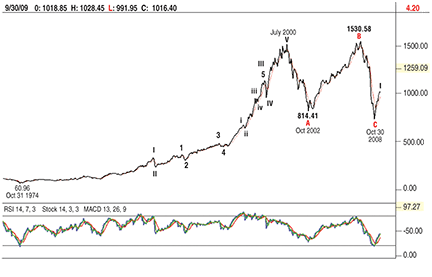CYCLES
The Boom & The Bust, Revisited
Kondratieff Wave Comeback
Will 2010 mark the end of the current recession? Use the Kondratieff wave to find out.
In my November 2008 Stocks & Commodities article, I concluded that “the US and world economies are headed for recessionary times,” with relief only after four years looking more and more likely with each passing week. Elliottician Robert Prechter, known for having predicted the stock market crash of 1987, has said in recent interviews that the sharp rebound in equities from 12-year lows hit in March 2009 has been only a near-time rally within a longer-term bear market. “The average investor who is not a trader should remain in the safest possible cash equivalents,” he said in his classic Elliott Wave Principle, cowritten with A.J. Frost.
I have always had a great respect for Prechter. Elliott Wave Principle was my tutor in Elliott wave theory, and when I was a South African resident, years ago, as a subscriber to his newsletter, I would often write him and ask for a further explanation of his wave count, which he always provided, mailed back to me, handwritten on a copy of his newsletter.
These days, however, I lean more toward Kondratieff theory. The reason for this can be provided with a look at the monthly chart of the Standard & Poor’s 500 (Figure 1).

Figure 1: MONTHLY CHART OF the s&p 500. The S&P500 index is currently in a Wave I up. This is confirmed by the RSI. The chart shows that the last time the RSI gave a buy signal was in October 1974, which was the start of a bull trend that lasted 26 years.
Figure 1 suggests that the S&P 500 is currently in a Wave I up. This is confirmed by the relative strength index (Rsi). The chart shows that the last time the Rsi gave a buy signal was in October 1974, which was the start of a bull trend that lasted 26 years. Now, we all know that a Wave 1 up is followed by a Wave 2 down, which can be either a simple or complicated wave. By this I mean a quick, fast retracement, or a long, drawn-out retracement. In Elliott Wave Principle, Frost and Prechter wrote: “Second waves often retrace so much of wave one that most of the profits gained up to that time are eroded away by the time it ends.”
Yes, there is a lot of negativity to come, and you can take profits and “remain in the safest possible cash equivalents” as Robert Prechter suggests, but you should not forget that the “bear” in a wave 2 is a correction in a major bull trend.